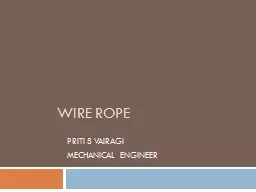

MECHANICAL ENGINEER A hoisting device use chain fibre or wire rope as its lifting medium Wire rope consists of several strands laid or twisted together like a helix Each strand is likewise made of metal wires laid together like a helix ID: 795341
Download The PPT/PDF document "Wire rope PRITI S VAIRAGI" is the property of its rightful owner. Permission is granted to download and print the materials on this web site for personal, non-commercial use only, and to display it on your personal computer provided you do not modify the materials and that you retain all copyright notices contained in the materials. By downloading content from our website, you accept the terms of this agreement.
Slide1
Wire rope
PRITI S VAIRAGI
MECHANICAL ENGINEER
Slide2A hoisting device use chain, fibre or wire rope as its lifting medium.
Wire rope consists of several strands laid (or ‘twisted’) together like a helix.
Each strand is likewise made of metal wires laid together like a helix.
Abrasion resistance increases with fewer, larger outside wires per strand and fatigue resistance increase with more outside smaller wires per strand.
Slide3Advantage of wire rope over chain
Steel wire ropes are extensively used in hoisting machinery as flexible lifting appliances. As compare to chains they have the following advantages:
Lighter weight.
Less
susceptibility to damage from jerk.
Silent
operation even at high working speed.
Greater
reliability in operation
Slide4Wire rope are manufactured from steel wire with an ultimate strength of σ = 1600 to 2000 N/mm2. In the process of manufacturing the wire is subjected to special heat treatment which, combined with cold drawing, imparts high mechanical properties to the wire
Slide5Ropes made from metal strands are called wire rope as shown in figure 12
Slide6Construction of wire rope :
Material
for steel wire ropes are generally high carbon steel. Most of the wire ropes are made up of IPS (improved
plaw
steel) with ultimate tensile strength (
σut
) of 2000 N/mm2, Several other grades are also used,
plaw
steel (
σut
= 1600 N/mm2) and mild
plaw
steel (
σut
= 1200 N/mm2).
Steel wires are manufactured by special machines. Initially separate wires are twisted to form the strands and strands are again twisted to form rope.
Slide7Designation of wire rope
construction of ropes is indicated by two numbers, 6×7, 6×19, 6×37 where 6 for No. of strands and 7,19,37 for No. of wires in each strands.
More the number of wires in each strand, more the flexible the rope will be. If number of wire is less the rope is stiffer.
6×7
:
rope is made up of heavy wires and provides maximum resistance to wear and vibration.
6×19
:
good
compromise between flexibility and wear. It is most popular and widely used.
6×37
:
Extra
flexible are used where abrasion and wear are not very severe. Relatively sharp bends can be tolerated.
Slide8The constructions of wire rope are shown in Figure 13 (a) and (b).
The wire rope consists of a number of strands, each strand comprising several steel wires. The number of wire in each strand is generally 7, 19 or 37, while the number of strands is usually six. The individual wires are first twisted into the strand and then the strands are twisted around a fibre or steel core
Slide9Specification of wire rope
The specifications of wire rope include two numbers, such as 6x7 or 6x19. The first number indicates the number of strand in the wire rope, while the second gives the number of steel wires in each strand.
The central portion of the rope is called core. There are three types of cores-fibre, wire and synthetic materials. The fibre core consists of natural fibre like sisal, hemp, jute or cotton. The fibre core is flexible and suitable for all conditions except when the rope is subjected to severe crushing.
Slide10The lay of the rope refers to the manner in which the wires are helically laid into strands and strand into the rope.
If the wires in the strand are twisted in the same directions as the strands, then the rope is called a Lang’s lay rope.
When the wire in the strand is twisted in directions opposite to that of strands, the rope is said to be regular–lay or ordinary-lay.
There are mainly three types of ropes parallel, composite and crossed.
Slide11The lays of wire rope is shown in the fig. (a)parallel, (b)composite and (c)crossed.